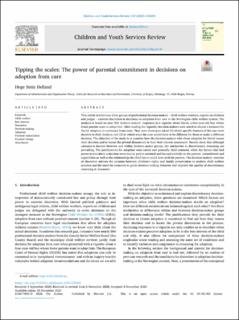| dc.contributor.author | Helland, Hege Beate Stein | |
| dc.date.accessioned | 2021-06-22T11:14:37Z | |
| dc.date.available | 2021-06-22T11:14:37Z | |
| dc.date.created | 2021-01-27T18:43:16Z | |
| dc.date.issued | 2020 | |
| dc.identifier.issn | 0190-7409 | |
| dc.identifier.uri | https://hdl.handle.net/11250/2760610 | |
| dc.description.abstract | This article studies how three groups of professional decision-makers – child welfare workers, experts on children and judges – exercise discretion in decisions on adoption from care in the Norwegian child welfare system. The analysis is based on near 500 decision-makers’ responses to a vignette about David, a four-year-old boy whose foster parents want to adopt him. After reading the vignette, decision-makers were asked to choose a measure for David: adoption or continued foster care. They were thereupon asked (1) which specific features of the case were decisive to their decision and (2) in which ways the case would have to be different for them to make a different decision. The objective of the study is to examine how the decision-makers who chose adoption for David reason their decision and to locate the pivotal dimensions in their best interest assessment. Results show that although variance is located between and within decision-maker groups, the similarities in discretionary reasoning are prevailing. The justifications for adoption were varied and generally child-centered, while the factors that had power to transform a decision were mainly parent-oriented and focused entirely on the parents’ commitment and capabilities as well as the relationship the child has or could have with his parents. The decision-makers’ exercise of discretion mirrors the tensions between children’s rights and family preservation in modern child welfare practice and the need for measures to guide decision-making behavior and improve the quality of discretionary reasoning is discussed. | en_US |
| dc.language.iso | eng | en_US |
| dc.publisher | Elsevier | en_US |
| dc.rights | Attribution-NonCommercial-NoDerivatives 4.0 Internasjonal | * |
| dc.rights.uri | http://creativecommons.org/licenses/by-nc-nd/4.0/deed.no | * |
| dc.title | Tipping the scales: The power of parental commitment in decisions on adoption from care | en_US |
| dc.type | Journal article | en_US |
| dc.type | Peer reviewed | en_US |
| dc.description.version | publishedVersion | en_US |
| dc.rights.holder | Copyright 2020 The Author | en_US |
| dc.source.articlenumber | 105693 | en_US |
| cristin.ispublished | true | |
| cristin.fulltext | original | |
| cristin.qualitycode | 1 | |
| dc.identifier.doi | 10.1016/j.childyouth.2020.105693 | |
| dc.identifier.cristin | 1880719 | |
| dc.source.journal | Children and Youth Services Review | en_US |
| dc.relation.project | Norges forskningsråd: 262773 | en_US |
| dc.identifier.citation | Children and Youth Services Review. 2020, 119, 105693 | en_US |
| dc.source.volume | 119 | en_US |

